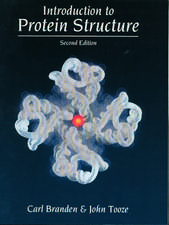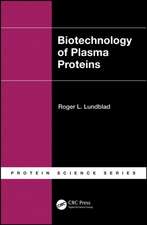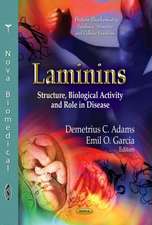Photoswitching Proteins: Methods and Protocols: Methods in Molecular Biology, cartea 1148
Editat de Sidney Cambridgeen Limba Engleză Hardback – 10 apr 2014
| Toate formatele și edițiile | Preț | Express |
|---|---|---|
| Paperback (1) | 694.51 lei 43-57 zile | |
| Springer – 17 sep 2016 | 694.51 lei 43-57 zile | |
| Hardback (1) | 651.34 lei 43-57 zile | |
| Springer – 10 apr 2014 | 651.34 lei 43-57 zile |
Din seria Methods in Molecular Biology
- 9%
 Preț: 791.63 lei
Preț: 791.63 lei - 23%
 Preț: 598.58 lei
Preț: 598.58 lei - 20%
 Preț: 882.98 lei
Preț: 882.98 lei -
 Preț: 252.05 lei
Preț: 252.05 lei - 5%
 Preț: 802.70 lei
Preț: 802.70 lei - 5%
 Preț: 729.61 lei
Preț: 729.61 lei - 5%
 Preț: 731.43 lei
Preț: 731.43 lei - 5%
 Preț: 741.30 lei
Preț: 741.30 lei - 5%
 Preț: 747.16 lei
Preț: 747.16 lei - 15%
 Preț: 663.45 lei
Preț: 663.45 lei - 18%
 Preț: 1025.34 lei
Preț: 1025.34 lei - 5%
 Preț: 734.57 lei
Preț: 734.57 lei - 18%
 Preț: 914.20 lei
Preț: 914.20 lei - 15%
 Preț: 664.61 lei
Preț: 664.61 lei - 15%
 Preț: 654.12 lei
Preț: 654.12 lei - 18%
 Preț: 1414.74 lei
Preț: 1414.74 lei - 5%
 Preț: 742.60 lei
Preț: 742.60 lei - 20%
 Preț: 821.65 lei
Preț: 821.65 lei - 18%
 Preț: 972.30 lei
Preț: 972.30 lei - 15%
 Preț: 660.49 lei
Preț: 660.49 lei - 5%
 Preț: 738.41 lei
Preț: 738.41 lei - 18%
 Preț: 984.92 lei
Preț: 984.92 lei - 5%
 Preț: 733.29 lei
Preț: 733.29 lei -
 Preț: 392.60 lei
Preț: 392.60 lei - 5%
 Preț: 746.26 lei
Preț: 746.26 lei - 18%
 Preț: 962.66 lei
Preț: 962.66 lei - 23%
 Preț: 860.22 lei
Preț: 860.22 lei - 15%
 Preț: 652.64 lei
Preț: 652.64 lei - 5%
 Preț: 1055.50 lei
Preț: 1055.50 lei - 23%
 Preț: 883.87 lei
Preț: 883.87 lei - 19%
 Preț: 491.89 lei
Preț: 491.89 lei - 5%
 Preț: 1038.86 lei
Preț: 1038.86 lei - 5%
 Preț: 524.16 lei
Preț: 524.16 lei - 18%
 Preț: 2122.34 lei
Preț: 2122.34 lei - 5%
 Preț: 1299.23 lei
Preț: 1299.23 lei - 5%
 Preț: 1339.12 lei
Preț: 1339.12 lei - 18%
 Preț: 1390.26 lei
Preț: 1390.26 lei - 18%
 Preț: 1395.63 lei
Preț: 1395.63 lei - 18%
 Preț: 1129.65 lei
Preț: 1129.65 lei - 18%
 Preț: 1408.26 lei
Preț: 1408.26 lei - 18%
 Preț: 1124.92 lei
Preț: 1124.92 lei - 18%
 Preț: 966.27 lei
Preț: 966.27 lei - 5%
 Preț: 1299.99 lei
Preț: 1299.99 lei - 5%
 Preț: 1108.51 lei
Preț: 1108.51 lei - 5%
 Preț: 983.76 lei
Preț: 983.76 lei - 5%
 Preț: 728.16 lei
Preț: 728.16 lei - 18%
 Preț: 1118.62 lei
Preț: 1118.62 lei - 18%
 Preț: 955.25 lei
Preț: 955.25 lei - 5%
 Preț: 1035.62 lei
Preț: 1035.62 lei - 18%
 Preț: 1400.35 lei
Preț: 1400.35 lei
Preț: 651.34 lei
Preț vechi: 766.28 lei
-15% Nou
Puncte Express: 977
Preț estimativ în valută:
124.65€ • 129.66$ • 102.91£
124.65€ • 129.66$ • 102.91£
Carte tipărită la comandă
Livrare economică 14-28 aprilie
Preluare comenzi: 021 569.72.76
Specificații
ISBN-13: 9781493904693
ISBN-10: 1493904698
Pagini: 288
Ilustrații: X, 278 p. 58 illus., 5 illus. in color.
Dimensiuni: 178 x 254 x 17 mm
Greutate: 0.72 kg
Ediția:2014
Editura: Springer
Colecția Humana
Seria Methods in Molecular Biology
Locul publicării:New York, NY, United States
ISBN-10: 1493904698
Pagini: 288
Ilustrații: X, 278 p. 58 illus., 5 illus. in color.
Dimensiuni: 178 x 254 x 17 mm
Greutate: 0.72 kg
Ediția:2014
Editura: Springer
Colecția Humana
Seria Methods in Molecular Biology
Locul publicării:New York, NY, United States
Public țintă
Professional/practitionerCuprins
Photoinduced Damage Resulting from Fluorescence Imaging of Live Cells.- Modification of Purified Proteins with Photochemical Protection Compounds for High-Resolution Photoactivation of Protein Function In Vitro and In Vivo.- Optochemical Activation of Kinase Function in Live Cells.- Photoswitching of Cell Surface Receptors Using Tethered Ligands.- Photocontrol of AMPA Receptors with a Photochromic Ligand.- Photoconversion of CFP to Study Neuronal Tissue with Electron Microscopy.- Light-Inducible Gene Regulation with Engineered Zinc Finger Proteins.- Manipulation of Plasma Membrane Phosphoinositides using Photoinduced Protein-protein Interactions.- A Roadmap to Applying Optogenetics in Neuroscience.- Salvaging Ruins: Reverting Blind Retinas into Functional Visual Sensors.- Photoactivated Adenylyl Cyclases as Optogenetic Modulators of Neuronal Activity.- Structural Basis of Photoswitching in Fluorescent Proteins.- Using Photoactivatable GFP to Track Axonal Transport Kinetics.- In Vivo Cell Tracking Using PhOTO Zebrafish.- In vivo Optogenetics for Light-induced Oxidative Stress in Transgenic Zebrafish Expressing the KillerRed Photosensitizer Protein.- Photoactivatable Fluorescent Proteins for Super-Resolution Microscopy.- pcSOFI as a Smart Label-based Superresolution Microscopy Technique.
Textul de pe ultima copertă
Photoswitching Proteins: Methods and Protocols, focuses on proven applications of photoswitching proteins in cell and neurobiology. Optical approaches have been mostly embraced by the neurosciences to allow fast, high-resolution characterization and manipulation of single cells in complex neuronal tissue. These tools, including photoswitching of proteins, are now successfully used in almost all fields of biological research. Written in the highly successful Methods in Molecular Biology series format, chapters include introductions to their respective topics, lists of the necessary materials and reagents, step-by-step, readily reproducible laboratory protocols, and key tips on troubleshooting and avoiding known pitfalls.
Comprehensive and practical, Photoswitching Proteins: Methods and Protocols highlights many of the possibilities for research based on light-inducible, high-resolution manipulation of biological systems.
Comprehensive and practical, Photoswitching Proteins: Methods and Protocols highlights many of the possibilities for research based on light-inducible, high-resolution manipulation of biological systems.
Caracteristici
Presents current up-to-date methodologies Provides step-by-step detail essential for reproducible results Contains key notes and implementation advice from the experts













